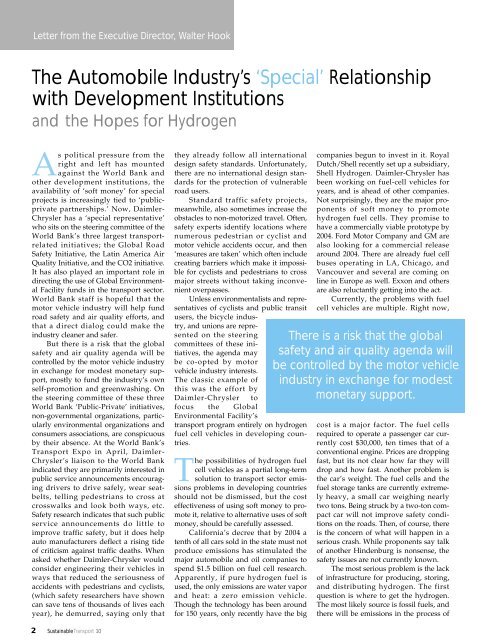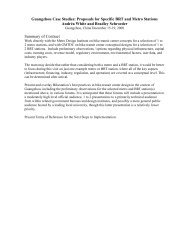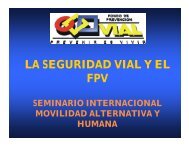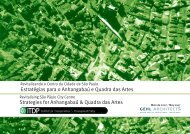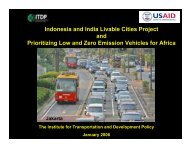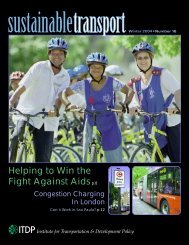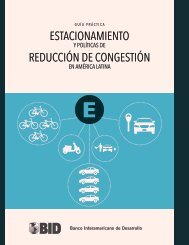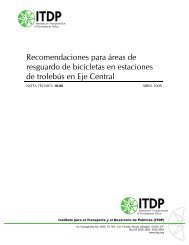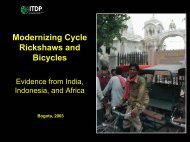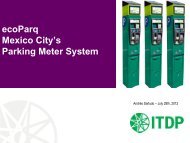Download PDF - ITDP | Institute for Transportation and Development ...
Download PDF - ITDP | Institute for Transportation and Development ...
Download PDF - ITDP | Institute for Transportation and Development ...
Create successful ePaper yourself
Turn your PDF publications into a flip-book with our unique Google optimized e-Paper software.
Letter from the Executive Director, Walter Hook<br />
The Automobile Industry’s ‘Special’ Relationship<br />
with <strong>Development</strong> Institutions<br />
<strong>and</strong> the Hopes <strong>for</strong> Hydrogen<br />
As political pressure from the<br />
right <strong>and</strong> left has mounted<br />
against the World Bank <strong>and</strong><br />
other development institutions, the<br />
availability of ‘soft money’ <strong>for</strong> special<br />
projects is increasingly tied to ‘publicprivate<br />
partnerships.’ Now, Daimler-<br />
Chrysler has a ‘special representative’<br />
who sits on the steering committee of the<br />
World Bank’s three largest transportrelated<br />
initiatives; the Global Road<br />
Safety Initiative, the Latin America Air<br />
Quality Initiative, <strong>and</strong> the CO2 initiative.<br />
It has also played an important role in<br />
directing the use of Global Environmental<br />
Facility funds in the transport sector.<br />
World Bank staff is hopeful that the<br />
motor vehicle industry will help fund<br />
road safety <strong>and</strong> air quality ef<strong>for</strong>ts, <strong>and</strong><br />
that a direct dialog could make the<br />
industry cleaner <strong>and</strong> safer.<br />
But there is a risk that the global<br />
safety <strong>and</strong> air quality agenda will be<br />
controlled by the motor vehicle industry<br />
in exchange <strong>for</strong> modest monetary support,<br />
mostly to fund the industry’s own<br />
self-promotion <strong>and</strong> greenwashing. On<br />
the steering committee of these three<br />
World Bank ‘Public-Private’ initiatives,<br />
non-governmental organizations, particularly<br />
environmental organizations <strong>and</strong><br />
consumers associations, are conspicuous<br />
by their absence. At the World Bank’s<br />
Transport Expo in April, Daimler-<br />
Chrysler’s liaison to the World Bank<br />
indicated they are primarily interested in<br />
public service announcements encouraging<br />
drivers to drive safely, wear seatbelts,<br />
telling pedestrians to cross at<br />
crosswalks <strong>and</strong> look both ways, etc.<br />
Safety research indicates that such public<br />
service announcements do little to<br />
improve traffic safety, but it does help<br />
auto manufacturers deflect a rising tide<br />
of criticism against traffic deaths. When<br />
asked whether Daimler-Chrysler would<br />
consider engineering their vehicles in<br />
ways that reduced the seriousness of<br />
accidents with pedestrians <strong>and</strong> cyclists,<br />
(which safety researchers have shown<br />
can save tens of thous<strong>and</strong>s of lives each<br />
year), he demurred, saying only that<br />
they already follow all international<br />
design safety st<strong>and</strong>ards. Un<strong>for</strong>tunately,<br />
there are no international design st<strong>and</strong>ards<br />
<strong>for</strong> the protection of vulnerable<br />
road users.<br />
St<strong>and</strong>ard traffic safety projects,<br />
meanwhile, also sometimes increase the<br />
obstacles to non-motorized travel. Often,<br />
safety experts identify locations where<br />
numerous pedestrian or cyclist <strong>and</strong><br />
motor vehicle accidents occur, <strong>and</strong> then<br />
‘measures are taken’ which often include<br />
creating barriers which make it impossible<br />
<strong>for</strong> cyclists <strong>and</strong> pedestrians to cross<br />
major streets without taking inconvenient<br />
overpasses.<br />
Unless environmentalists <strong>and</strong> representatives<br />
of cyclists <strong>and</strong> public transit<br />
users, the bicycle industry,<br />
<strong>and</strong> unions are represented<br />
on the steering<br />
committees of these initiatives,<br />
the agenda may<br />
be co-opted by motor<br />
vehicle industry interests.<br />
The classic example of<br />
this was the ef<strong>for</strong>t by<br />
Daimler-Chrysler to<br />
focus the Global<br />
Environmental Facility’s<br />
transport program entirely on hydrogen<br />
fuel cell vehicles in developing countries.<br />
The possibilities of hydrogen fuel<br />
cell vehicles as a partial long-term<br />
solution to transport sector emissions<br />
problems in developing countries<br />
should not be dismissed, but the cost<br />
effectiveness of using soft money to promote<br />
it, relative to alternative uses of soft<br />
money, should be carefully assessed.<br />
Cali<strong>for</strong>nia’s decree that by 2004 a<br />
tenth of all cars sold in the state must not<br />
produce emissions has stimulated the<br />
major automobile <strong>and</strong> oil companies to<br />
spend $1.5 billion on fuel cell research.<br />
Apparently, if pure hydrogen fuel is<br />
used, the only emissions are water vapor<br />
<strong>and</strong> heat: a zero emission vehicle.<br />
Though the technology has been around<br />
<strong>for</strong> 150 years, only recently have the big<br />
companies begun to invest in it. Royal<br />
Dutch/Shell recently set up a subsidiary,<br />
Shell Hydrogen. Daimler-Chrysler has<br />
been working on fuel-cell vehicles <strong>for</strong><br />
years, <strong>and</strong> is ahead of other companies.<br />
Not surprisingly, they are the major proponents<br />
of soft money to promote<br />
hydrogen fuel cells. They promise to<br />
have a commercially viable prototype by<br />
2004. Ford Motor Company <strong>and</strong> GM are<br />
also looking <strong>for</strong> a commercial release<br />
around 2004. There are already fuel cell<br />
buses operating in LA, Chicago, <strong>and</strong><br />
Vancouver <strong>and</strong> several are coming on<br />
line in Europe as well. Exxon <strong>and</strong> others<br />
are also reluctantly getting into the act.<br />
Currently, the problems with fuel<br />
cell vehicles are multiple. Right now,<br />
There is a risk that the global<br />
safety <strong>and</strong> air quality agenda will<br />
be controlled by the motor vehicle<br />
industry in exchange <strong>for</strong> modest<br />
monetary support.<br />
cost is a major factor. The fuel cells<br />
required to operate a passenger car currently<br />
cost $30,000, ten times that of a<br />
conventional engine. Prices are dropping<br />
fast, but its not clear how far they will<br />
drop <strong>and</strong> how fast. Another problem is<br />
the car’s weight. The fuel cells <strong>and</strong> the<br />
fuel storage tanks are currently extremely<br />
heavy, a small car weighing nearly<br />
two tons. Being struck by a two-ton compact<br />
car will not improve safety conditions<br />
on the roads. Then, of course, there<br />
is the concern of what will happen in a<br />
serious crash. While proponents say talk<br />
of another Hindenburg is nonsense, the<br />
safety issues are not currently known.<br />
The most serious problem is the lack<br />
of infrastructure <strong>for</strong> producing, storing,<br />
<strong>and</strong> distributing hydrogen. The first<br />
question is where to get the hydrogen.<br />
The most likely source is fossil fuels, <strong>and</strong><br />
there will be emissions in the process of<br />
2 SustainableTransport 10


